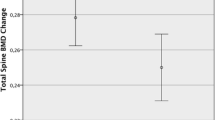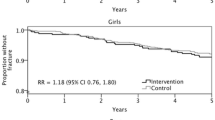Abstract
We studied the effect in children of an exercise intervention program on fracture rates and skeletal traits. Fractures were registered for 5 years in a population-based prospective controlled exercise intervention study that included children aged 6–9 years at study start, 446 boys and 362 girls in the intervention group and 807 boys and 780 girls in the control group. Intervention subjects received 40 min/school day of physical education and controls, 60 min/week. In 73 boys and 48 girls in the intervention group and 52 boys and 48 girls in the control group, bone mineral density (BMD, g/cm2) and bone area (mm2) were followed annually by dual-energy X-ray absorptiometry, after which annual changes were calculated. At follow-up we also assessed trabecular and cortical volumetric BMD (g/cm3) and bone structure by peripheral computed tomography in the tibia and radius. There were 20.0 fractures/1,000 person-years in the intervention group and 18.5 fractures/1,000 person-years in the control group, resulting in a rate ratio of 1.08 (0.79–1.47) (mean and 95 % CI). The gain in spine BMD was higher in both girls (difference 0.01 g/cm2, 0.005–0.019) and boys (difference 0.01 g/cm2, 0.001–0.008) in the intervention group. Intervention girls also had higher gain in femoral neck area (difference 0.04 mm2, 0.005–0.083) and at follow-up larger tibial bone mineral content (difference 0.18 g, 0.015–0.35), larger tibial cortical area (difference 17 mm2, 2.4–31.3), and larger radial cross-sectional area (difference 11.0 mm2, 0.63–21.40). As increased exercise improves bone mass and in girls bone size without affecting fracture risk, society ought to encourage exercise during growth.

Similar content being viewed by others
References
Hind K, Burrows M (2007) Weight-bearing exercise and bone mineral accrual in children and adolescents: a review of controlled trials. Bone 40(1):14–27
Bradney M, Pearce G, Naughton G, Sullivan C, Bass S, Beck T, Carlson J, Seeman E (1998) Moderate exercise during growth in prepubertal boys: changes in bone mass, size, volumetric density, and bone strength: a controlled prospective study. J Bone Miner Res 13(12):1814–1821
McKay HA, Petit MA, Schutz RW, Prior JC, Barr SI, Khan KM (2000) Augmented trochanteric bone mineral density after modified physical education classes: a randomized school-based exercise intervention study in prepubescent and early pubescent children. J Pediatr 136(2):156–162
Petit MA, McKay HA, MacKelvie KJ, Heinonen A, Khan KM, Beck TJ (2002) A randomized school-based jumping intervention confers site and maturity-specific benefits on bone structural properties in girls: a hip structural analysis study. J Bone Miner Res 17(3):363–372
MacKelvie KJ, Khan KM, Petit MA, Janssen PA, McKay HA (2003) A school-based exercise intervention elicits substantial bone health benefits: a 2-year randomized controlled trial in girls. Pediatrics 112(6 Pt 1):e447
MacKelvie KJ, Petit MA, Khan KM, Beck TJ, McKay HA (2004) Bone mass and structure are enhanced following a 2-year randomized controlled trial of exercise in prepubertal boys. Bone 34(4):755–764
Linden C, Alwis G, Ahlborg H, Gardsell P, Valdimarsson O, Stenevi-Lundgren S, Besjakov J, Karlsson MK (2007) Exercise, bone mass and bone size in prepubertal boys: one-year data from the pediatric osteoporosis prevention study. Scand J Med Sci Sports 17(4):340–347
Linden C, Ahlborg HG, Besjakov J, Gardsell P, Karlsson MK (2006) A school curriculum-based exercise program increases bone mineral accrual and bone size in prepubertal girls: two-year data from the Pediatric Osteoporosis Prevention (POP) study. J Bone Miner Res 21(6):829–835
Valdimarsson O, Linden C, Johnell O, Gardsell P, Karlsson MK (2006) Daily physical education in the school curriculum in prepubertal girls during 1 year is followed by an increase in bone mineral accrual and bone width—data from the prospective controlled Malmo Pediatric Osteoporosis Prevention study. Calcif Tissue Int 78(2):65–71
Alwis G, Linden C, Ahlborg HG, Dencker M, Gardsell P, Karlsson MK (2008) A 2-year school-based exercise programme in pre-pubertal boys induces skeletal benefits in lumbar spine. Acta Paediatr 97(11):1564–1571
Lanyon LE (1992) Control of bone architecture by functional load bearing. J Bone Miner Res 7(Suppl 2):S369–S375
Rubin CT, Lanyon LE (1984) Regulation of bone formation by applied dynamic loads. J Bone Joint Surg Am 66(3):397–402
Hui SL, Slemenda CW, Johnston CC Jr (1990) The contribution of bone loss to postmenopausal osteoporosis. Osteoporos Int 1(1):30–34
Melton LJ 3rd, Atkinson EJ, O’Fallon WM, Wahner HW, Riggs BL (1993) Long-term fracture prediction by bone mineral assessed at different skeletal sites. J Bone Miner Res 8(10):1227–1233
Kannus P, Haapasalo H, Sankelo M, Sievanen H, Pasanen M, Heinonen A, Oja P, Vuori I (1995) Effect of starting age of physical activity on bone mass in the dominant arm of tennis and squash players. Ann Intern Med 123(1):27–31
Hasselstrom HA, Karlsson MK, Hansen SE, Gronfeldt V, Froberg K, Andersen LB (2008) A 3-year physical activity intervention program increases the gain in bone mineral and bone width in prepubertal girls but not boys: the prospective Copenhagen School Child Interventions Study (CoSCIS). Calcif Tissue Int 83(4):243–250
Johnell O, Gullberg B, Kanis JA, Allander E, Elffors L, Dequeker J, Dilsen G, Gennari C, LopesVaz A, Lyritis G et al (1995) Risk factors for hip fracture in European women: the MEDOS Study. Mediterranean Osteoporosis Study. J Bone Miner Res 10(11):1802–1815
Clark EM, Ness AR, Tobias JH (2008) Vigorous physical activity increases fracture risk in children irrespective of bone mass: a prospective study of the independent risk factors for fractures in healthy children. J Bone Miner Res 23(7):1012–1022
Jonsson B, Gardsell P, Johnell O, Redlund-Johnell I, Sernbo I (1994) Remembering fractures: fracture registration and proband recall in southern Sweden. J Epidemiol Community Health 48(5):489–490
Dencker M, Thorsson O, Karlsson MK, Linden C, Eiberg S, Wollmer P, Andersen LB (2006) Daily physical activity related to body fat in children aged 8–11 years. J Pediatr 149(1):38–42
Duke PM, Litt IF, Gross RT (1980) Adolescents’ self-assessment of sexual maturation. Pediatrics 66(6):918–920
Ferretti JL, Capozza RF, Zanchetta JR (1996) Mechanical validation of a tomographic (pQCT) index for noninvasive estimation of rat femur bending strength. Bone 18(2):97–102
Duan Y, Parfitt A, Seeman E (1999) Vertebral bone mass, size, and volumetric density in women with spinal fractures. J Bone Miner Res 14(10):1796–1802
Duan Y, Seeman E, Turner CH (2001) The biomechanical basis of vertebral body fragility in men and women. J Bone Miner Res 16(12):2276–2283
Ahlborg HG, Johnell O, Turner CH, Rannevik G, Karlsson MK (2003) Bone loss and bone size after menopause. N Engl J Med 349(4):327–334
Clark EM, Ness AR, Tobias JH (2008) Bone fragility contributes to the risk of fracture in children, even after moderate and severe trauma. J Bone Miner Res 23(2):173–179
Karlsson MK, Linden C, Karlsson C, Johnell O, Obrant K, Seeman E (2000) Exercise during growth and bone mineral density and fractures in old age. Lancet 355(9202):469–470
Nordstrom A, Karlsson C, Nyquist F, Olsson T, Nordstrom P, Karlsson M (2005) Bone loss and fracture risk after reduced physical activity. J Bone Miner Res 20(2):202–207
Manias K, McCabe D, Bishop N (2006) Fractures and recurrent fractures in children; varying effects of environmental factors as well as bone size and mass. Bone 39(3):652–657
Guadalupe-Grau A, Fuentes T, Guerra B, Calbet JA (2009) Exercise and bone mass in adults. Sports Med 39(6):439–468
Heinonen A, Oja P, Kannus P, Sievanen H, Haapasalo H, Manttari A, Vuori I (1995) Bone mineral density in female athletes representing sports with different loading characteristics of the skeleton. Bone 17(3):197–203
Nikander R, Sievanen H, Heinonen A, Kannus P (2005) Femoral neck structure in adult female athletes subjected to different loading modalities. J Bone Miner Res 20(3):520–528
Stenevi-Lundgren S, Daly RM, Linden C, Gardsell P, Karlsson MK (2009) Effects of a daily school based physical activity intervention program on muscle development in prepubertal girls. Eur J Appl Physiol 105(4):533–541
Treuth MS, Hunter GR, Figueroa-Colon R, Goran MI (1998) Effects of strength training on intra-abdominal adipose tissue in obese prepubertal girls. Med Sci Sports Exerc 30(12):1738–1743
Acknowledgement
We thank the teachers and students for participating in the study. Financial support for this study was received from ALF, the Centre for Athletic Research, the Osterlund Foundation, the Kock Foundation, and the Region Skåne Foundation.
Author information
Authors and Affiliations
Corresponding author
Additional information
The authors have stated that they have no conflict of interest.
Rights and permissions
About this article
Cite this article
Detter, F.T.L., Rosengren, B.E., Dencker, M. et al. A 5-Year Exercise Program in Pre- and Peripubertal Children Improves Bone Mass and Bone Size Without Affecting Fracture Risk. Calcif Tissue Int 92, 385–393 (2013). https://doi.org/10.1007/s00223-012-9691-5
Received:
Accepted:
Published:
Issue Date:
DOI: https://doi.org/10.1007/s00223-012-9691-5




